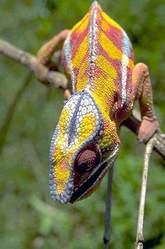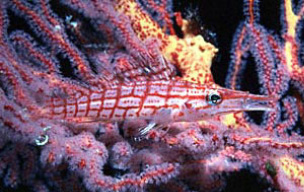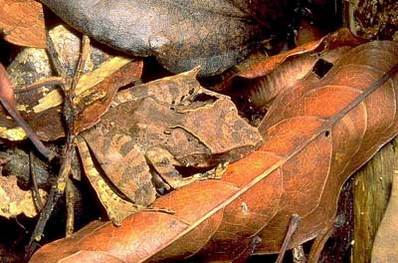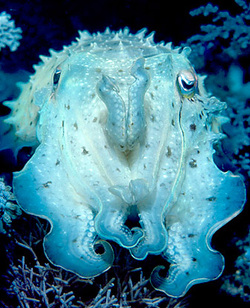Camouflage
Chameleon, indigenous to the Central Rainforest

Darwin’s theory of survival of the fittest heavily relates to the idea of camouflaging animals. Camouflaging animals use their body’s to blend into their surroundings. They are then able to hide from their predators - therefore have a better chance of survival, and of passing their genes on to the next generation. This use of camouflage is also beneficial to the animals because it allows them to also find food. By blending into their surroundings, animals can also sneak up on their prey and catch them without too much of a fight. Camouflage depends on the physiology of the particular animal and the environment that it lives in. The nature of the predator is also important to the animal that is using camouflage. These animals need to know crucial information about their predators and those that are hunting them. For instance, if a predator is color-blind, then the color of the prey is un-important, this animal only needs to have a similar pattern to it's background.
Tartan Hawfkish, Great Barrier Reef

The ways in which camouflaging is done depends on the type of exterior the animal has. Pigments in skin cells called biochromes, are able to reflect colors and light to produce new colors chemically. Other animals simply use the light and refract them like prisms to get the coloration that they desire. They use the wavelengths in the visible color spectrum to get the light to reflect from the pigment. In example, the polar bear actually has black skin but because the white fur on top is able to cover most of it's body, the light reflects off of the fur and makes it blend on top of the majority of the surface mass of the polar bear.
Animals are also able to change their external features due to their environment. These animals adapt, or change, their features because their environment changes. For instance, the changing of seasons can cause the environment to change, and animals will respond to that by changing themselves to accommodate this. The hormones in some animals react to the amount of daylight that is felt on the animal’s skin, or temperature changes. These changes cause modifications in the biochromes - allowing them to alter their features. In some cases, fur color. However, since fur and feathers are actually dead tissue, an animal has to grow all new fur or create a new coat of feathers in order for this change to happen. Therefore animals must act quickly and respond to their environment in time to change their inner-layers of skin, called the chromatophore. The chromatophore contains only a single pigment. These pigments are contained inside a circular muscle and when this muscle contracts, the pigment is forced to the top, displaying their color. When the muscle is relaxing the pigment is pushed down and the color of their true skin is shown. This can happen simultaneously and therefore show different colors at the same time. By taking in the color of the background, they can contract certain muscles to blend in and make any different number of colors and patterns so as to blend into the environment.
Animals are also able to change their external features due to their environment. These animals adapt, or change, their features because their environment changes. For instance, the changing of seasons can cause the environment to change, and animals will respond to that by changing themselves to accommodate this. The hormones in some animals react to the amount of daylight that is felt on the animal’s skin, or temperature changes. These changes cause modifications in the biochromes - allowing them to alter their features. In some cases, fur color. However, since fur and feathers are actually dead tissue, an animal has to grow all new fur or create a new coat of feathers in order for this change to happen. Therefore animals must act quickly and respond to their environment in time to change their inner-layers of skin, called the chromatophore. The chromatophore contains only a single pigment. These pigments are contained inside a circular muscle and when this muscle contracts, the pigment is forced to the top, displaying their color. When the muscle is relaxing the pigment is pushed down and the color of their true skin is shown. This can happen simultaneously and therefore show different colors at the same time. By taking in the color of the background, they can contract certain muscles to blend in and make any different number of colors and patterns so as to blend into the environment.
Cryptic Frog, can you see him?

Not all animals need to change in order to blend into their surroundings. Some animals are born with a certain pattern of colors. These patterns may be identical to
the animal’s environment, or may just serve as a visual distraction. In these types of animals the predators can’t tell where the body of the prey starts and ends. In other words, it looks as if the animal never starts or begins, that it is one continuous mass. If these animals are in one large herd, it makes it even more difficult for the predator to stalk one specific animal in that herd.They can’t pick out which one is on the outside since their body grass and patterns all run together. In the case of the zebra, the stripes all blur together making their predator, the lion, unable to pick out one specific zebra from the herd. And also because of their stripes they are able to hide
among the grass, since the lion is colorblind, the black and white stripes of the zebra actually blend into the tan and green stripes of the grass on the Savannah.
the animal’s environment, or may just serve as a visual distraction. In these types of animals the predators can’t tell where the body of the prey starts and ends. In other words, it looks as if the animal never starts or begins, that it is one continuous mass. If these animals are in one large herd, it makes it even more difficult for the predator to stalk one specific animal in that herd.They can’t pick out which one is on the outside since their body grass and patterns all run together. In the case of the zebra, the stripes all blur together making their predator, the lion, unable to pick out one specific zebra from the herd. And also because of their stripes they are able to hide
among the grass, since the lion is colorblind, the black and white stripes of the zebra actually blend into the tan and green stripes of the grass on the Savannah.
Fun Facts!
Here are some really cool facts about camouflage...

- Did you know that some animals use camouflage to communicate with each other? Animals like the Cuttlefish send out warning signs by changing their exterior color. Other Cuttlefish in the area temporarily change color as well, but then must quickly change back to the color of the backdrop they are on to avoid getting eaten.
- Some animals, like the chameleon, change colors based on their moods. The chameleon can sometimes camouflage to the background, and if spotted turn a shade that looks alarming to the predator. This is only used as a last result, but is somewhat effective. When the chameleon is not in a defensive situation, it will remain the color that is based solely on its mood.
- Camouflage came from the French word, camofleur, meaning to blind or veil. Basically, it means to disguise something, or hide it in plain sight. When animals - or even humans - use camouflage, they are at first hard to see, but when you take a closer look, they are fairly easy to spot. The goal is for the predator to pass by long enough for the prey to escape unharmed. Some animals can hold their positions for hours, whereas some only wait until the predator is out of sight. As soon as the coast is clear they make a dash to shelter.
- Camouflage isn't always about color. Some animals prefer to hide and mask their scents instead. By rolling around in dung, predators only smell feces and quickly move on, due to the horrible smell. In this way, the prey is able to disguise itself and stay out of harms way.
- Most dolphins and whales are actually dark on their stomachs and light on the top. These animals can now not be seen from a bottom angle, or from a top angle. The sun hitting the water makes a large bright spot on the surface, where dolphins tend to spend most of their times. Whales on the other hand - who are able to hold their breathe twice as long as dolphins - spend the most time in the middle, so both colors are needed. Predators, therefore, have a much harder time seeing them.
- Giraffe's blotchy pattern mimics the light coming through trees. In the Savanna, trees are generally very tall and the Giraffe's skinny legs are able to blend in like the trunk of trees. By standing directly behind the trees, predators do not see them and they are able to continue living for another day.
- Some animals, like the chameleon, change colors based on their moods. The chameleon can sometimes camouflage to the background, and if spotted turn a shade that looks alarming to the predator. This is only used as a last result, but is somewhat effective. When the chameleon is not in a defensive situation, it will remain the color that is based solely on its mood.
- Camouflage came from the French word, camofleur, meaning to blind or veil. Basically, it means to disguise something, or hide it in plain sight. When animals - or even humans - use camouflage, they are at first hard to see, but when you take a closer look, they are fairly easy to spot. The goal is for the predator to pass by long enough for the prey to escape unharmed. Some animals can hold their positions for hours, whereas some only wait until the predator is out of sight. As soon as the coast is clear they make a dash to shelter.
- Camouflage isn't always about color. Some animals prefer to hide and mask their scents instead. By rolling around in dung, predators only smell feces and quickly move on, due to the horrible smell. In this way, the prey is able to disguise itself and stay out of harms way.
- Most dolphins and whales are actually dark on their stomachs and light on the top. These animals can now not be seen from a bottom angle, or from a top angle. The sun hitting the water makes a large bright spot on the surface, where dolphins tend to spend most of their times. Whales on the other hand - who are able to hold their breathe twice as long as dolphins - spend the most time in the middle, so both colors are needed. Predators, therefore, have a much harder time seeing them.
- Giraffe's blotchy pattern mimics the light coming through trees. In the Savanna, trees are generally very tall and the Giraffe's skinny legs are able to blend in like the trunk of trees. By standing directly behind the trees, predators do not see them and they are able to continue living for another day.
Resources:
Websites-
"HowStuffWorks "How Animal Camouflage Works"" HowStuffWorks - Learn How Everything Works! Web. 27 Apr. 2011. <http://www.howstuffworks.com/animal-camouflage.htm>.
"General Logon Page." Gale Error Page. Web. 27 Apr. 2011. <http://ic.galegroup.com/ic/scic/ReferenceDetailsPage/ReferenceDetailsWindow?displayGroupName=Reference>.
Images -
All of these images came from the same website, same photographer, same URL.
Curtis, Chris. "Curiosity "Animal Camouflage Pictures"" Curiosity. Chris Hondros/Getty Images. Web. 27 Apr. 2011. http://curiosity.discovery.com/topic/ecology-and-the-environment/animal-camouflage-pictures11.htm.
Websites-
"HowStuffWorks "How Animal Camouflage Works"" HowStuffWorks - Learn How Everything Works! Web. 27 Apr. 2011. <http://www.howstuffworks.com/animal-camouflage.htm>.
"General Logon Page." Gale Error Page. Web. 27 Apr. 2011. <http://ic.galegroup.com/ic/scic/ReferenceDetailsPage/ReferenceDetailsWindow?displayGroupName=Reference>.
Images -
All of these images came from the same website, same photographer, same URL.
Curtis, Chris. "Curiosity "Animal Camouflage Pictures"" Curiosity. Chris Hondros/Getty Images. Web. 27 Apr. 2011. http://curiosity.discovery.com/topic/ecology-and-the-environment/animal-camouflage-pictures11.htm.
